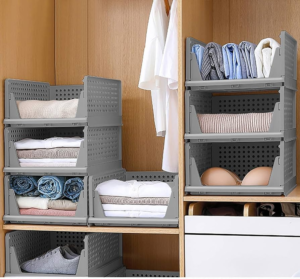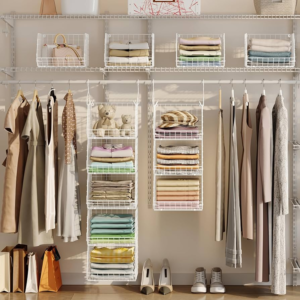Having a clutter-free, well-organized wardrobe is not just aesthetically pleasing but can significantly simplify your daily routine. In this guide, we’ll delve into the intricacies of how wardrobe organizers work, providing insights into their functionality and the benefits they bring to your everyday life.
Wardrobe organizers operate on a simple yet ingenious principle: maximizing space and accessibility. These systems are designed to efficiently store, categorize, and display your clothing and accessories, turning your wardrobe into a streamlined haven.
These organizers come in various forms, from modular shelves and drawers to hanging compartments and shoe racks. The key is to customize the system according to your needs and the available space in your wardrobe.



As we explore further, you’ll discover practical tips on optimizing your wardrobe, making the most out of your space and effortlessly finding that perfect outfit every morning.
1: Understanding Your Wardrobe’s Needs
The first step in making a wardrobe organizer work for you is understanding your storage needs. Evaluate your clothing collection, considering different categories such as shirts, pants, dresses, and accessories. The goal is to create dedicated spaces for each, ensuring easy retrieval.
2: Sorting and Decluttering
Before implementing a wardrobe organizer, it’s essential to declutter your wardrobe. Donate or discard items you no longer need, creating space for the pieces that truly matter. Wardrobe organizers are most effective when dealing with a curated collection.
3: Utilizing Hanging Solutions
One popular aspect of wardrobe organizers is the use of hanging solutions. Invest in quality hangers and arrange your clothes by type and color. This not only looks visually appealing but also makes it easier to locate specific items.
4: Maximizing Shelf Space
Shelves are a fundamental part of wardrobe organizers. They provide a platform for folded items, accessories, or even storage boxes. The key is to stack items neatly, making the most of the available space.
5: Incorporating Drawer Dividers
Wardrobe organizers often include drawer dividers to keep smaller items like socks, underwear, or accessories in order. These dividers prevent items from becoming jumbled, ensuring a tidy and accessible drawer space.
6: Shoe Racks and Compartments
For shoe enthusiasts, wardrobe organizers offer specialized racks or compartments. This not only keeps your shoes in pristine condition but also prevents clutter at the bottom of your wardrobe.
7: Rotating Carousel Systems
Innovative wardrobe organizers may include rotating carousels, particularly useful for those with limited space. These systems allow you to access different sections of your wardrobe with a simple turn.
8: Customization for Seasonal Changes
Wardrobe organizers are adaptable. Consider customizing your setup to accommodate seasonal changes in your wardrobe. This ensures that your space remains optimized year-round.

In conclusion, a wardrobe organizer is not just a piece of furniture; it’s a lifestyle upgrade. By understanding your wardrobe’s needs, decluttering effectively, and utilizing the various components of a wardrobe organizer, you transform your closet into a functional and stylish space.
Embark on this organizational journey and witness the positive impact it can have on your daily life. Your wardrobe isn’t just a collection of clothes; it’s a reflection of your personality and style—let a wardrobe organizer help you showcase it effortlessly.


